I was at the EDUCAUSE Annual Conference that was held from Oct 30-Nov 2 in Denver. I have accepted to be a member of the Nominations Committee of EDUCAUSE. There was an early meeting on Tuesday, that I needed to attend, so I arrived on Monday, Oct 29. It was a beautiful day with temperatures in mid to high 70’s. But then, it was all downhill, cold and a day of rain.
EDUCAUSE’s commitment to diversity and inclusion was evident everywhere this year. It all started with the Nominations Committee where we discussed the importance of creating a diverse pool of candidates for the Board. You could see it in messaging, programming and social media posts. I have been going to EDUCAUSE for quite a while and the lack of diversity was striking at the beginning, but it has continued to improve, but we have a long way to go.
I was active in twitter during the conference and you can see my tweets here.
(more…)
It is National Cybersecurity Awareness Month (NCSAM) and I thought I will share some of the ways I protect my information. Spoiler alert: you may not find anything that you already don’t know and I may have written about these earlier. And if you came to the event at Wellesley last Friday, you already heard about these from me. But I hope this serves as a good reminder about some of the best practices for keeping your information safe.
Passwords & Passphrases
I use fairly long and complex passwords. I prefer passphrases wherever they are supported. It is so sad that so many systems still do not support passphrases and are restrictive in terms of the length of the passwords. As a rule, I use different passwords for different systems. I will be very happy to privately share with anyone who is interested in knowing more about how I maintain/remember all of these passwords. I also avoid saving passwords for some of the critical systems and financial institutions in my browser’s password manager. They are safe and continue to be safer, but, if ever someone steals my Google Password AND bypasses two factor authentication, they will have access to all my passwords (paranoia!).
To change the passwords often or not is an age old question and I believe that having a long and hard to guess password is much better than changing passwords often. One of the reasons for mandating the password change was that if hackers had access to your password, changing it prevents them from accessing your data and that it is hard for them to guess your new password. With the exponential increase in computing power, the moment your password has been hacked, a lot of your information has already been accessed before you can change the password. Secondly, it has been shown that mandatory password changes result in predictable password patterns that are easier to guess than one can imagine. I encourage you to read this article “Time to rethink mandatory password changes” on this subject. So, my advice – make passwords long and hard to guess. (more…)
There is continuing controversy as to whether the claims that certain motherboards manufactured in China were fitted with tiny microchips that are capable of compromising data. Details as to what exactly this means is less important than the answers to “what if” questions. The chip could potentially install malware or open up a port silently for the hackers to invade any of the systems using such a motherboard. It could also potentially inflict other major damages such as erasing all data or corrupt the data slowly (in some intelligent ways) so that even backups over a period of time makes it impossible to retrieve the data. And it may be programmed to be dormant and wake up in some future date. Who knows?
Planting such “easter eggs” is a common practice in software, but not necessarily with the intent of causing damage, but more as a joke or for fun. Programmers of video games or computer software planted these for fun. For example, TECO editor from TOPS-10 operating system (in the late 70s and early 80’s) used the command make to create a file. If you typed “make love” to create a file called love, it had an easter egg which would respond by saying “not war?“. Most recently, Google engineers have been creating a fair amount of easter eggs.
I want to tell you a story about my question on this subject some 8 years ago…
(more…)
I landed in this country on September 10th, 1978 and completed my 40th anniversary a couple of days ago. I am forever thankful for being able to come here and like several millions of others, no one ever would have predicted this would be my future. After losing my parents very early, I grew up with my uncle and aunt in Colombo, Sri Lanka. Thirteen of us in all (11 cousins, my sister and I), cramped up in a house roughly the size of a two bedroom apartment. I had no specific plans academically except I was very interested and curious. I was the only one of the 13 to pass the high school finals (which was a national exam) and since the admission to one of the then 4 Universities in Sri Lanka was next to impossible, my relatives funded my education in India.
I loved the undergraduate school I went to and then was fortunate to get into one of the best universities in India, Indian Institute of Technology, (IIT) Madras, where I did my Masters. My family wanted to me to work so I can support them financially. By that time, I was fascinated by quantum chemistry and really wanted to study further. To satisfy the family, I went for an interview at Bhaba Atomic Research Center (BARC). I was acing the interview and the interviewer asked me whether I thought of first doing a PhD and then applying to BARC. I told him that that was what I would really like to do. We then chatted for a half an hour about cricket and I left and he wished me well in seeking admission to a PhD program. I never heard from BARC!
Since almost everyone from IIT came to the US for Masters or PhD, that is what I also did. I applied to some four schools and got into one, CUNY. Thanks to students from IIT coming before me doing well, Professor David Beveridge was glad to have me in his flourishing group in Hunter College at CUNY.
(more…)
The technology transformations in the past 10-15 years has been remarkable. It is mostly driven by the internet, but there also have been several other advances in technologies that have helped accelerate research and development across the board. It has also leveled the playing field for many. For example, many authors and artists have been successful in directly reaching out to an audience through the internet that simply wasn’t possible before. The channels for success before the internet was limited, complicated and dismal.
But this also has resulted in a massive growth in the availability of information that are uncurated, biased, incorrect, so on and so forth. This has become such a huge problem that even for seasoned folks it is becoming impossible to identify whether some of what we see and read are true and accurate. One of the many horrifying examples is a recent horrifying story from India about a fake post that spread like wildfire through WhatsApp. Major technology companies like Google and Facebook continue to put in safeguards, but those intent on misusing the system bypass these immediately.
Everyone is busy producing new gadgets and monetizing the user base that no one seems to be investing enough in finding solutions for the long haul. They are busy finding bandaids and the blood appears to stop for a short period before gushing out!
(more…)
This is the time of the year when you hear “Where did the summer go?”. Thats right, summer just went and here we are, welcoming our students over the next few days before the classes begin. Our attention at this point is getting some of the most important communication out to the faculty, staff and students about the changes in matters related to the Library and Technology and making sure that every service that our faculty, staff and students rely on, that we support, works and works reliably and well.
We have an exciting year ahead of us with some major projects such as Workday Student, which I will continue to write as we march forward. We will soon be releasing news about a course catalog app based on course data from Workday, now that we have curriculum management live in Workday. We have some exciting news for our students in terms of their eligibility to become members of the Wellesley Free Library and enjoy the member benefits. (more…)
I have been a little lazy about writing though I have been pretty busy as always. I did write something in July for EDUCAUSE Review about the new role of IT. As you can see there, I was talking about our major initiative, Workday implementation, and summarized the lessons learned:
- Accept mistakes and correct them quickly. These complex projects affect a wide range of users, and it is impossible to capture all of the use cases and user needs up front. You should develop appropriate response strategy after the initial roll out by anticipating that you will hear complaints—especially from users who cannot do what they used to do in the older system. When this happens, accept responsibility for it, offer alternatives, and prioritize their delivery based on the institutional impact.
- Never underestimate the importance of change management. No matter how much you prepare, you will always fall short in managing the change and you will always receive complaints about issues ranging from communication style and frequency (for some it is too much, and for others it is too little) to too many new terminologies to not enough training or training at inconvenient times. To prepare, you should over-communicate, create targeted communications, and offer a lot of training, both for groups and individuals. You should continue these activities beyond the initial rollout and for however long it takes to help users acclimate to the new system. Also, where possible, ease users into the new system rather than cutting over everything one fine day.
- Establish clear governance and goals. It is very important to set achievable goals and make sure the community understands them. Further, having a clear governance structure is crucial for such a major implementation. Ensure that your governance body can make decisions quickly and that the implementation team can rely on it for crisis management, because plenty of crises will arise all along the way!
- Time your training appropriately. Staff members will be eager to get as much training as possible as quickly as possible. Timing the training in such a way that your staff can put it to use as soon as possible is essential. Avoid sending staff to training too early at all costs; waiting too long to send them is also unproductive. Choosing the optimal time—typically, within 60 days of rollout—is key.
- Praise the staff often and reward their efforts. Some staff members will enthusiastically participate in the project and view it as once in a lifetime opportunity. Because the work will be very demanding, praising your team members for the good work they do is critical to keeping morale high. Plan to reward staff performance as well, which will be very much appreciated.
- There will be staff turnover, so plan for it. At the most inopportune times, you will encounter turnovers. Some people will not want to go through an ERP transition and will leave midstream; their loss will likely be hard. Others will move on after gaining experience in the new system. These departures will diminish team morale, so planning ahead, having a strategy, and being up front and open with your entire team about these events—and how you plan to respond to them—will serve you well in the end.
(more…)

Niest Point Lighthouse Isle of Skye
Scotland turned out to be everything I had heard from my friends who have visited the country before. We were so lucky to have fantastic weather on all the days we stayed there. The temperatures were in the high 70s to low 80s, sunny always. The technology there seemed pretty advanced. When we entered the cab, there were multiple signs saying how the taxis had free WiFi, they accepted credit cards and touch free payments from the phone. When we asked for a taxi that accepts credit card, the airport staff looked at us like “why are you even asking me this question!”
We stayed in a nice hotel in the Old Town near all the usual attractions and walking distance from the University of Edinburgh, where my wife had a conference. We walked to almost all the attractions nearby and burned a few calories, advantages of the big cities! It is a safe place and the fact that there is sunlight from about 4:30 AM till almost 11 PM meant we had a lot more time in the day to explore the city, which we did. One day I walked all the way from where I was staying to Leith, which is a port.
We also took Uber to a couple of places, which was a piece of cake. The Uber drivers were friendly and one of them was telling me how he cannot understand why people drive for Uber part time because it is a pretty poor return on investment. Ok, noted!
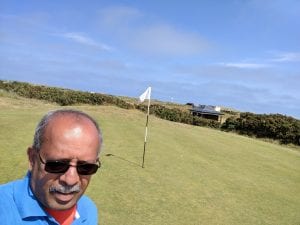
I putted that ball in, really!
I drove alone to St Andrews one day to test my luck on getting to play in the Old course. Of course I had made sure that I will be getting a car with automatic transmission, which I did. I am not afraid of driving on the left side, though it takes a bit of time to get adjusted to. It was doubly challenging this time around because I needed to listen to the Google Maps instructions and deal with too many turns in the roundabouts. Long story short, I was pretty close to playing in the Old course, but the woman, who was trying to get me in, finally advised me to play in Jubilee course instead because it was not going to be possible to get me on the Old course. Oh, well, I tried. I played with a gentleman from Arizona in the Jubilee course, who said he has a 10 stroke advantage over me in terms of our handicaps. And I am very proud to say that I did extremely well, given that I walked all 18 holes carrying my clubs and played 8 strokes better than my partner, who was using a rolling cart!
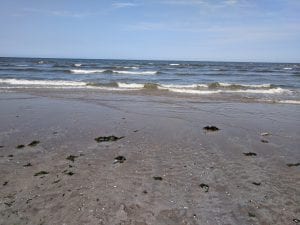
Beach – St Andrews
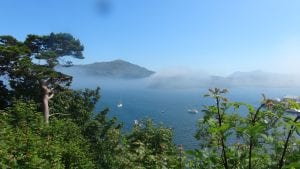
Mountains and the fog – Isle of Skye
 My wife and I drove for four days. We thoroughly enjoyed the sceneries, the castles, the mountain ranges, the beaches, just the greenery for however long the eyes can see and the friendly people of Scotland. Vegetarian food was a non issue wherever we went. Bed and Breakfast where we stayed were comfortable.
My wife and I drove for four days. We thoroughly enjoyed the sceneries, the castles, the mountain ranges, the beaches, just the greenery for however long the eyes can see and the friendly people of Scotland. Vegetarian food was a non issue wherever we went. Bed and Breakfast where we stayed were comfortable.
Google Maps and Waze were fabulous in directing us. Waze was also cautioning me about the speed limits and speed traps, thank you! They both failed miserably in directing us to gas stations, restaurants and coffee shops. They are simply not accurate in Scotland, especially in smaller towns. In one case, it took us to a Starbucks in Aberdeen at the University there. Unfortunately Starbucks is closed on a Sunday. Not only that, they only open Monday-Friday from 8:30-3:30. Just when I thought Google knew everything, it failed me. At that point, I really wanted a Starbucks coffee and was looking forward to it. We were almost out of gas when we let Inverness to go to Loch Ness. Google said there is a gas stations 9 miles from where we were. When it said you have arrived at your destination, it was right, that we were 9 miles south of Inverness, but no gas station was in sight. We found it the old fashioned way. We asked a human who said, you are better off going back to Inverness, which is what we did, a narrow escape from some unpleasantness.
I am not going to bore you with my travel details, except to say that we drove to the Cairngorms National Park, the Isle of Skye, Speyside, Aberdeen and the Angus Costal route to St Andrews again and back to Edinburgh. The advantages of driving are clear. We got to make so many unplanned stops and changed plans a couple of times.
On the way to Isle of Skye, we were amazed to see an Indian restaurant called “Taste of India” soon after we entered the Isle after crossing a beautiful bridge in Kyle. We wanted to check it out, but were not hungry. It will turn out that many of the small towns we crossed on the way had an Indian restaurant! On the way back, we found it again and stopped for dinner. The parking lot was full and the restaurant was packed! We were seated and were instructed to order everything at the same time because if we wanted to order something later, it will take time. Well, we ordered what we could eat. The food was average. There is a minimum of 10 pounds per person, as in British currency and not weight of food! We finished and gave my credit card for 21.30 pounds. The guy taking it said I can pay 20 pounds in cash rather than charge. Sure, that was a good discount!
We went all the way to the westernmost point in the Isle of Skye – Niest Point Lighthouse. An area with fantastic views of the Atlantic Ocean and cliffs. The drive was a bit unusual in that a long stretch of it is a single lane and you need to negotiate which side is going first. There are spots for one side to park and let the other side go. It was all so civil and well executed. Some of the drives were through small villages and I have the same exact question that I always have – where do they get their groceries, what exactly do they do for a living (most likely farming or fishing), where do they get their petrol and diesel (because I did not come across many gas stations on the way), and where do they buy cars and get them serviced? I was tempted to stop and ask, but then, they may think I am a nut job! If and when I retire, I want to travel differently and stop and ask these questions. They nag me to no end!

One of the places we stopped on the way that was fabulous – Dunnottar Castle Joys of driving.
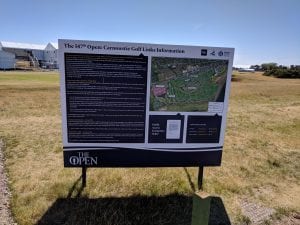
Carnoustie
We made two unforgettable detours. One is to Dunnottar Castle and another to Carnoustie. The Castle, it turned out, was the best detour we made. Absolutely wonderful setting and views. Carnoustie, of course, is where the next Bristish Open will be played in 3 weeks. We can see all signs of the course getting ready – electronic scoreboards are to be seen at the 18th green. It is a small town with a few tight roads and I wonder how the town will deal with the massive crowds that will descend on them.
We ended our drive by stopping at St Andrews and walking a few holes. That’s right, on most Sundays, the golf course becomes a public park of sorts and the public can just wander around. A few greens are off limits, but other than that, you can wander as you please. I am amazed at the trust placed in the visitors to not do any damage to the course. There were no staff babysitting the visitors!
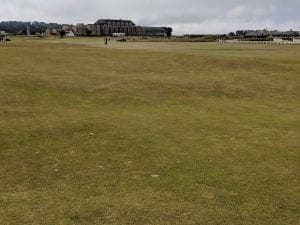
Walking the St Andrews Old Course
With the exception of Isle of Skye, there was absolutely no issue with cell and data access in Scotland. This time around we decided to sign up for the AT&T deal of $10 a day where all the data consumed is charged to your own existing plan (I have unlimited data!). And guess what, you can also make phone calls to the US. I couldn’t believe it, so I double checked and it was confirmed. We made some phone calls back home and I will find out if this is a deal that holds! This was a blessing because I didn’t have to worry about turning data roaming on and off, configuring Google Photos to not sync when not connected to WiFi etc. In the larger scheme of things, for a travel like this, $10 a day seemed like a no brainer.
Now, back to work to earn a living, so I can go on my next vacation in December…

Green’s View, Sewanee. A beautiful that adjoins the University’s golf course that you can walk to.
I have not been able to post blogs because of my travels during the last couple of weeks in June. First, I was at the annual meeting of Consortium of Liberal Arts Colleges (CLAC) at the University of the South at Sewanee, Tennessee. Then, my wife and I traveled in Scotland for a few days.
I really enjoy the CLAC meetings because it is a fairly small gathering of like minded colleagues from other small liberal arts colleges with plenty of time built in for networking. The keynotes and the presentations I went to were very interesting, including a keynote by the John M. McCardell, JR., Vice Chancellor of the University of the South, who provided a vigorous defense of liberal arts institutions. Of course, he was preaching to the choir and touched on many of the challenges we continue to face.
(more…)
I am sure that many of you are aware that GMail has undergone a major change and it will be pushed to all users in the next few months (details of when seems to vary – August or October). I have been using Google Inbox for a while now and love it because of some of the features such as easy access to add reminders, snoozing emails, the nudges and auto response (handy when I am driving – I respond this way only when I am stopped at a light otherwise it is by voice!). The new Gmail incorporates all of these and a few more. I am beginning to use the new GMail now because Inbox has lacked some of the features of GMail.
This change is going to be pretty disruptive to a lot of our users and we are preparing to handle it as best as we can. Frankly, those of us who use smartphones see changes to apps on a regular basis and one would think that everyone is used to it now. Absolutely not! Change is complicated – all of us like some changes, but not all; the same change is liked by some but not others. Those of us who are in the business of providing services need to handle this on a regular basis and it is extremely hard.
(more…)








